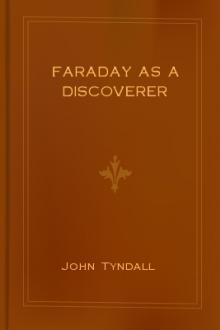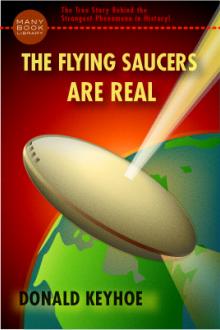Faraday as a Discoverer by John Tyndall (ebook reader with built in dictionary TXT) 📕

- Author: John Tyndall
- Performer: -
Book online «Faraday as a Discoverer by John Tyndall (ebook reader with built in dictionary TXT) 📕». Author John Tyndall
In my own case, a brotherly welcome was everywhere manifested.
In fact, the differences of really honourable and sane men are never beyond healing.
Chapter 5.
Identity of electricities; first researches on electro-chemistry.
I have already once used the word ‘discomfort’ in reference to the occasional state of Faraday’s mind when experimenting. It was to him a discomfort to reason upon data which admitted of doubt.
He hated what he called ‘doubtful knowledge,’ and ever tended either to transfer it into the region of undoubtful knowledge, or of certain and definite ignorance. Pretence of all kinds, whether in life or in philosophy, was hateful to him. He wished to know the reality of our nescience as well as of our science. ‘Be one thing or the other,’
he seemed to say to an unproved hypothesis; ‘come out as a solid truth, or disappear as a convicted lie.’ After making the great discovery which I have attempted to describe, a doubt seemed to beset him as regards the identity of electricities. ‘Is it right,’ he seemed to ask, ‘to call this agency which I have discovered electricity at all?
Are there perfectly conclusive grounds for believing that the electricity of the machine, the pile, the gymnotus and torpedo, magneto-electricity and thermo-electricity, are merely different manifestations of one and the same agent?’ To answer this question to his own satisfaction he formally reviewed the knowledge of that day.
He added to it new experiments of his own, and finally decided in favour of the ‘Identity of Electricities.’ His paper upon this subject was read before the Royal Society on January 10 and 17, 1833.
After he had proved to his own satisfaction the identity of electricities, he tried to compare them quantitatively together.
The terms quantity and intensity, which Faraday constantly used, need a word of explanation here. He might charge a single Leyden jar by twenty turns of his machine, or he might charge a battery of ten jars by the same number of turns. The quantity in both cases would be sensibly the same, but the intensity of the single jar would be the greatest, for here the electricity would be less diffused.
Faraday first satisfied himself that the needle of his galvanometer was caused to swing through the same arc by the same quantity of machine electricity, whether it was condensed in a small battery or diffused over a large one. Thus the electricity developed by thirty turns of his machine produced, under very variable conditions of battery surface, the same deflection. Hence he inferred the possibility of comparing, as regards quantity, electricities which differ greatly from each other in intensity. His object now is to compare frictional with voltaic electricity. Moistening bibulous paper with the iodide of potassium—a favourite test of his—and subjecting it to the action of machine electricity, he decomposed the iodide, and formed a brown spot where the iodine was liberated.
Then he immersed two wires, one of zinc, the other of platinum, each 1/13th of an inch in diameter, to a depth of 5/8ths of an inch in acidulated water during eight beats of his watch, or 3/20ths of a second; and found that the needle of his galvanometer swung through the same arc, and coloured his moistened paper to the same extent, as thirty turns of his large electrical machine. Twenty-eight turns of the machine produced an effect distinctly less than that produced by his two wires. Now, the quantity of water decomposed by the wires in this experiment totally eluded observation; it was immeasurably small; and still that amount of decomposition involved the development of a quantity of electric force which, if applied in a proper form, would kill a rat, and no man would like to bear it.
In his subsequent researches ‘On the absolute Quantity of Electricity associated with the Particles or Atoms of matter,’
he endeavours to give an idea of the amount of electrical force involved in the decomposition of a single grain of water. He is almost afraid to mention it, for he estimates it at 800,000
discharges of his large Leyden battery. This, if concentrated in a single discharge, would be equal to a very great flash of lightning; while the chemical action of a single grain of water on four grains of zinc would yield electricity equal in quantity to a powerful thunderstorm. Thus his mind rises from the minute to the vast, expanding involuntarily from the smallest laboratory fact till it embraces the largest and grandest natural phenomena.[1]
In reality, however, he is at this time only clearing his way, and he continues laboriously to clear it for some time afterwards.
He is digging the shaft, guided by that instinct towards the mineral lode which was to him a rod of divination. ‘Er riecht die Wahrheit,’
said the lamented Kohlrausch, an eminent German, once in my hearing:—
‘He smells the truth.’ His eyes are now steadily fixed on this wonderful voltaic current, and he must learn more of its mode of transmission.
On May 23, 1833, he read a paper before the Royal Society ‘On a new Law of Electric Conduction.’ He found that, though the current passed through water, it did not pass through ice:—why not, since they are one and the same substance? Some years subsequently he answered this question by saying that the liquid condition enables the molecule of water to turn round so as to place itself in the proper line of polarization, while the rigidity of the solid condition prevents this arrangement. This polar arrangement must precede decomposition, and decomposition is an accompaniment of conduction. He then passed on to other substances; to oxides and chlorides, and iodides, and salts, and sulphurets, and found them all insulators when solid, and conductors when fused. In all cases, moreover, except one—and this exception he thought might be apparent only—he found the passage of the current across the fused compound to be accompanied by its decomposition. Is then the act of decomposition essential to the act of conduction in these bodies?
Even recently this question was warmly contested. Faraday was very cautious latterly in expressing himself upon this subject; but as a matter of fact he held that an infinitesimal quantity of electricity might pass through a compound liquid without producing its decomposition. De la Rive, who has been a great worker on the chemical phenomena of the pile, is very emphatic on the other side.
Experiment, according to him and others, establishes in the most conclusive manner that no trace of electricity can pass through a liquid compound without producing its equivalent decomposition.[2]
Faraday has now got fairly entangled amid the chemical phenomena of the pile, and here his previous training under Davy must have been of the most important service to him. Why, he asks, should decomposition thus take place?—what force is it that wrenches the locked constituents of these compounds asunder? On the 20th of June, 1833, he read a paper before the Royal Society ‘On Electrochemical Decomposition,’ in which he seeks to answer these questions.
The notion had been entertained that the poles, as they are called, of the decomposing cell, or in other words the surfaces by which the current enters and quits the liquid, exercised electric attractions upon the constituents of the liquid and tore them asunder. Faraday combats this notion with extreme vigour. Litmus reveals, as you know, the action of an acid by turning red, turmeric reveals the action of an alkali by turning brown. Sulphate of soda, you know, is a salt compounded of the alkali soda and sulphuric acid.
The voltaic current passing through a solution of this salt so decomposes it, that sulphuric acid appears at one pole of the decomposing cell and alkali at the other. Faraday steeped a piece of litmus paper and a piece of turmeric paper in a solution of sulphate of soda: placing each of them upon a separate plate of glass, he connected them together by means of a string moistened with the same solution. He then attached one of them to the positive conductor of an electric machine, and the other to the gas-pipes of this building. These he called his ‘discharging train.’
On turning the machine the electricity passed from paper to paper through the string, which might be varied in length from a few inches to seventy feet without changing the result. The first paper was reddened, declaring the presence of sulphuric acid; the second was browned, declaring the presence of the alkali soda.
The dissolved salt, therefore, arranged in this fashion, was decomposed by the machine, exactly as it would have been by the voltaic current. When instead of using the positive conductor he used the negative, the positions of the acid and alkali were reversed.
Thus he satisfied himself that chemical decomposition by the machine is obedient to the laws which rule decomposition by the pile.
And now he gradually abolishes those so-called poles, to the attraction of which electric decomposition had been ascribed.
He connected a piece of turmeric paper moistened with the sulphate of soda with the positive conductor of his machine; then he placed a metallic point in connection with his discharging train opposite the moist paper, so that the electricity should discharge through the air towards the point. The turning of the machine caused the corners of the piece of turmeric paper opposite to the point to turn brown, thus declaring the presence of alkali. He changed the turmeric for litmus paper, and placed it, not in connection with his conductor, but with his discharging train, a metallic point connected with the conductor being fixed at a couple of inches from the paper; on turning the machine, acid was liberated at the edges and corners of the litmus. He then placed a series of pointed pieces of paper, each separate piece being composed of two halves, one of litmus and the other of turmeric paper, and all moistened with sulphate of soda, in the line of the current from the machine.
The pieces of paper were separated from each other by spaces of air.
The machine was turned; and it was always found that at the point where the electricity entered the paper, litmus was reddened, and at the point where it quitted the paper, turmeric was browned. ‘Here,’
he urges, ‘the poles are entirely abandoned, but we have still electrochemical decomposition.’ It is evident to him that instead of being attracted by the poles, the bodies separated are ejected by the current. The effects thus obtained with poles of air he also succeeded in obtaining with poles of water. The advance in Faraday’s own ideas made at this time is indicated by the word ‘ejected.’ He afterwards reiterates this view: the evolved substances are expelled from the decomposing body, and ‘not drawn out by an attraction.
Having abolished this idea of polar attraction, he proceeds to enunciate and develop a theory of his own. He refers to Davy’s celebrated Bakerian Lecture, given in 1806, which he says ‘is almost entirely occupied in the consideration of electrochemical decompositions.’ The facts recorded in that lecture Faraday regards as of the utmost value. But ‘the mode of action by which the effects take place is stated very generally; so generally, indeed, that probably a dozen precise schemes of electrochemical action might be drawn up, differing essentially from each other, yet all agreeing with the statement there given.’
It appears to me that these words might with justice be applied to Faraday’s own researches at this time. They furnish us with results of permanent value; but little help can be found in the theory advanced to account for them. It would, perhaps, be more correct to say that the theory itself is hardly presentable in any tangible form to the intellect. Faraday looks, and rightly looks,





Comments (0)